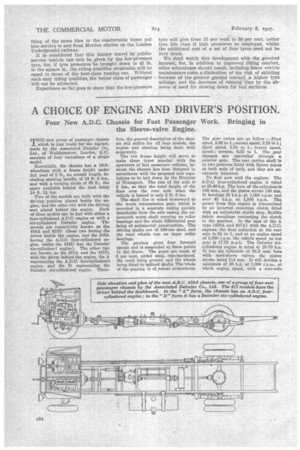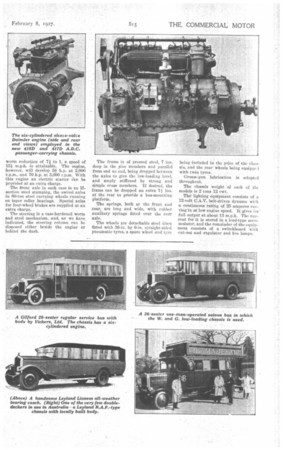A CHOICE OF ENGINE AND DRIVER'S POSITION.
Page 120

Page 121

If you've noticed an error in this article please click here to report it so we can fix it.
Four New A.D.C. Chassis for Fast Passenger Work. Bringing in the Sleeve-valve Engine.
rplIE new group of passenger chassis 1 which is just ready for the market, made by the Associated Daimler Go., Ltd., of Walthamstow, London, E.17, consists of four variations of a single model.
Essentially, the chassis has a 16-ft. wheelbase with a frame height under full load of 2 ft., an overall length, including starting handle, of 24 ft. 6 ins., and with a turning circle of 60 ft., the space available behind the dash being 14 ft. 1f
Two of the models are built with the driving position placed beside the engine, and the other two with the driving seat placed behind the engine. Each of these models can be had wit' h either a four-cylinclered A.D.C. engine or with a six-eylindered Daimler engine. The models are respectively known as the 416A and 41611 (these two having the driver beside the engine, and the 416A having the A.D.C. four-cylindered engine, whilst the 416D has the Daimler six-cylinderei engine). The other two are known as the 417A and the 4171), with the driver behind the engine, the A representing the A.D.C. four-cylindered engine, and the D representing the Daimler six-eylindered engine. There fore, the general description of the chassis will suffice for all four models, the engine and steering being dealt with separately.
The low frame height will serve to make these types popular with the operators of fast passenger vehicles, because the chassis has been designed in accordance with the proposed new regulations to be laid down by the Minister of Transport. The rise of the axle is 5 ins., so that the total height of the floor over the rear axle when the vehicle is loaded is only 2 ft. 5 ins.
The shaft line is raked downward to the worm transmission gear, which is mounted in a separate casing quickly detachable from the axle easing, the underneath worm shaft running on roller bearings and the whole differential gear being of substantial construction. The driving shafts are of 100-ton steel, and the road wheels run on taper roller bearings.
The gearbox gives four forward speeds and is suspended at three points in the frame. The gears are made of 5 per cent. nickel steel, case-hardened, the teeth being ground and the wheels being fitted Co splined shafts. The whole of the gearing is of robust proportions.
The gear ratios are as follow :—First speed, 5.06 to 1; second speed, 2.79 to 1; third speed, 1.70 to 1; fourth speed, direct; reverse, 6.32 to 1. The gear changes are controlled through a selector gate. The rear carder' shaft is in two portions fitted with Spicer joints at both ends of each, and they are accurately balanced.
To deal now with the engines. The A.D.C. four-cylindered engine is rated at 35-40 h.p. The bore of the cylinders is 108 mm., and the piston stroke 140 mm. It develops 38 b.h.p. at 1,000 r.p.m. and over 45 b.h.p. at 1,500 r.p.m. The power from this engine is transmitted by an inverted cone-type clutch fitted with an adjustable dutch stop, flexible fabric eouplings connecting the clutch to the gearbox. In the case of the A type (416A and 417A) with the A.D.C. engines, the final reduction at the rear axle is 61 to 1, and at an engine speed of 1,000 r.p.m. the vehicle speed on top gear is 17.72 m.p.h. The Daimler sixcylindered engine is rated at 25-70 h.p. It has six cylinders of 81.5 tom. bore with steel-sleeve valves, the piston stroke being 114 mm. It will develop a minimum of 30 h.p. at 1,000 r.p.m., at which engine speed, with a rear-axle
worm reduction. of 7* to 1, a speed of 15i m.p.h, is attainable. The engine, however, will develop 58 h.p. at 2.000 r.p.m., and 70 h.p. at 3,000 r.p.m. With this engine an electric starter can be prqvided at an extra charge.
The front axle in each case is an Hsection steel stamping, the swivel axles in 60-tan steel carrying wheels running on taper roller bearings. Special axles for four-wheel brakes are supplied at an extra charge.
The steering is a case-hardened worm and steel mechanism, and, as we have indicated, the steering column can be disposed either beside the engine or behind the dash, The frame is of pressed steel, 7 ins. deep in the sitie members and parallel from end to end, being dropped between the axles to give the low-loading level, and amply stiffened by strong and simple cross members. If desired, the frame can be dropped an extra 7i ins. at the rear to provide a bus-mounting platform.
The springs, both at the front and rear, are long and wide, with rubber auxiliary springs fitted over the rear axle.
The wheels are detachable steel discs fitted with 36-in. by 6-in. straight-sided pneumatic tyres, a spare wheel and tyre being included in tho price of the chassis, and the rear wheels being equippe with twin tyres. • . Crease-gun lubrication is adopted throughout.
The chassis weight of each of the models is 2 tons 12 cwt.
The' lighting equipment consists of a 12-volt C.A.V. belt-driven dynamo vdrli a continuous rating of 25 amperes cutting in at low engine speed. It gives its' full output at about 13 m.p.h. The current for it is stored in a lead-type accumulator, and the remainder of the equipment consists of a switchboard with cut-out and regulator and five lamps.




































































































































































































